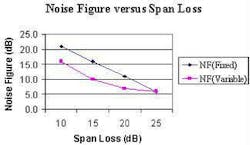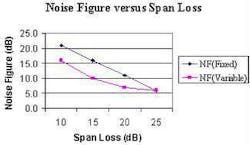Intelligent EDFAs are essential for metro networks
Next-generation metro EDFAs enable flexible, scalable, and robust metropolitan and regional optical networks.
By Gokul Rajaram and Timothy E. Waters
Onetta, Inc.
With a growing requirement to support the rapid deployment and increased complexity of metro networks, a new breed of EDFAs has come of age in metro DWDM systems. Combining innovative functionality with superior intelligence and control, these EDFAs facilitate the deployment of higher-bandwidth wavelength services with greater assurance of network availability. Carriers benefit by increased revenue opportunities while lowering overall network deployment and operating costs.
First-generation metro EDFAs
Metro DWDM systems and EDFAs have evolved over the last few years and must continue to advance to keep pace with network evolution. Although first-generation, fixed-gain metro EDFAs offer reasonable value, they suffer from three significant limitations:
Next-generation metro EDFAs
Next-generation metro EDFAs are flexible and tunable dynamic subsystems that integrate electronics, optics, and software to significantly improve the economics of deploying and managing amplified metro networks. Metro EDFAs provide several important features, such as software-tunable variable gain, ultra-fast transient control, mid-stage access, wide gain and input power dynamic range, and in-service software upgrade. These features not only improve functionality and performance, but also help reduce operational expenditures (OpEx) for NSPs.
Metro EDFAs feature widely variable optical gain, enabling them to deliver better system performance, i.e., higher OSNR, over shorter spans relative to fixed-gain EDFAs. Additionally, incorporating the attenuation function within an EDFA eliminates the separately managed attenuation devices from the network, simplifying network management and provisioning.
The gain setting is software-adjustable by the network management system (NMS), enabling system re-configuration with "key strokes instead of truck rolls." Advanced functionality minimizes both manual intervention and training, substantially lowering NSP OpEx.
Ultra-fast transient control
Next-generation metro EDFAs also offer ultra-fast transient control, enabling a system to automatically compensate for fluctuations in optical power levels caused by dynamic channel add/drops and network reconfigurations. The speed of the transient response affects the degree of performance protection the system provides to surviving channels under fast-changing networking scenarios. To be effective, EDFAs must exhibit excellent transient characteristics over all input power and gain settings, a wide variety of spectral loading conditions, and the entire operating temperature range.
Effective transient control results in a more robust network by preventing data loss in the event of equipment failures or during network upgrades, which are performed without service disruption to static channels. Furthermore, carriers can now provision additional wavelengths for their customers without incurring burdensome operating expenses, i.e., sending people and equipment to each amplification location to re-tune devices. NSPs gain a competitive edge by using software to dynamically reconfigure their networks to meet customers' service provisioning needs.
Mid-stage access
Next-generation broadband metro EDFAs offer mid-stage access to compensate for the insertion loss of DCMs. Without mid-stage access, either the span loss has to be small enough that the DCM can be inserted into the span, or two single-stage EDFAs need to be used with a DCM in between, creating an expensive and bulky architecture. Mid-stage access can therefore significantly alleviate the cost impact of scaling regional networks to OC-192 traffic.
Wide gain and input power dynamic range
In today's economic environment, NSPs are adopting a success-based CapEx model, wherein new channels are provisioned on an as-needed basis. The same network that carries one optical channel today may transport eight channels a month from now, and 32 channels by the end of the year.
As optical signal power levels recognized by EDFAs are dependent on the number of channels and input power level of each channel, an EDFA needs to operate efficiently over an extremely wide input power range. In most cases, the wide input power range is nearly 40 dB. Other considerations include providing variable gain functionality and a range of gain settings. Extremely short spans, for example, may have span node losses of 10 dB while, on the other extreme, regional links can exhibit 25-dB loss. Therefore, a gain range of at least 15 dB is desirable, with superior optical performance over the entire gain range to ensure suitable OSNR irrespective of span loss.
In-service software upgrades
Much of the functionality in broadband metro EDFAs is enabled through intelligent firmware embedded in the module, and closely integrated with the electronics. This firmware must be periodically upgraded to accommodate system software updates. Next-generation metro EDFAs that offer "hitless" or in-service software upgrades allow subsystem software to be upgraded remotely while a unit continues to amplify live traffic. As NSPs start offering guaranteed uptimes and other service level agreements, they will enforce this requirement more stringently in all of the systems in their network (and by implication, the subsystems in those systems).
Summary
Next-generation metro EDFAs enable NSPs to build flexible, scalable, and robust metropolitan and regional optical networks. They possess software-enabled tunability and intelligence, and offer a compelling value proposition to NSPs by reducing the overall cost of operations for network service providers, while providing extensive capabilities to accommodate customer growth and innovative revenue-generating network services. These EDFAs will be a key driver behind the growth of metro networks.
Gokul Rajaram is a product manager at Onetta's Sunnyvale, CA headquarters.
Timothy E. Waters is vice president, marketing and business development at Onetta.


